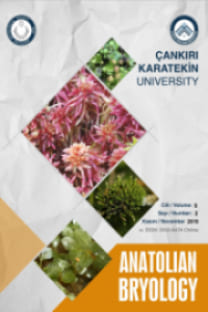Bazı Karayosunu Türlerinin (Cinclidotus riparius (Host ex Brid.) Arn., Calliergonella cuspidata (Hedw.) Loeske, Thamnobryum alopecurum (Hedw.) Gangulee, Leucobryum juniperoideum (Brid.) Müll.Hal., Cirriphyllum crassinervium (Taylor) Loeske & M.Fleisch.) Antibakteriyel Aktivitesinin Belirlenmesi
Bu çalışmada, Zonguldak çevresinde bol bulunan 5 farklı karayosunu (Cinclidotus riparius (Host ex Brid.) Arn., Calliergonella cuspidata (Hedw.) Loeske, Thamnobryum alopecurum (Hedw.) Gangulee, Leucobryum juniperoideum (Brid.) Müll.Hal., Cirriphyllum crassinervium (Taylor) Loeske & M.Fleisch.) ekstraktlarının, 13 farklı bakteri kültürüne karşı antibakteriyel etkileri incelenmiştir. Ekstreler etanol, aseton, metanol ve etil asetat (%96) içinde hazırlanmıştır. Karayosunu ekstraktlarının antibakteriyel aktivitesinin belirlenmesi için Disk Difüzyon yöntemi uygulanmıştır. Buna ilaveten, sadece çözgenlerin emdirilmiş olduğu disklerle birlikte standart antibiyotik diskler de kıyas amaçlı kullanılmıştır. Çalışma sonunda, Escherichia coli ATCC 11230’ye karşı T. alopecurum’un metanol ve aseton ekstreleri ile L. juniperoideum’un metanol ektresinin diğer çalışılan tüm karayosunu türlerinden daha fazla antibakteriyel aktivite gösterdikleri belirlenmiştir. Ayrıca T. alopecurum’un etanolik ve asetonik ekstrelerinin aktiviteleri standart olarak çalışılan antibiyotik disklerinden AK30 (Amikasin)’in etkisinden fazla CTX30 (Sefotaksim)’in etkisi ile aynıydı. Bununla birlikte L. juniperoideum’un metanol ekstresinin antibakteriyel etkisinin yalnızca AK30 (Amikasin)’den daha yüksek olduğu görülmüştür.
Determining Antibacterial Activity of Some Mosses (Cinclidotus riparius (Host ex Brid.) Arn., Calliergonella cuspidata (Hedw.) Loeske, Thamnobryum alopecurum (Hedw.) Gangulee, Leucobryum juniperoideum (Brid.) Müll. Hal., Cirriphyllum crassinervium (Taylor) Loeske & M.Fleisch.)
In this study, the antibacterial activity of 5 different moss extracts (Cinclidotus riparius (Host ex Brid.) Arn., Calliergonella cuspidata (Hedw.) Loeske, Thamnobryum alopecurum (Hedw.) Gangulee, Leucobryum juniperoideum (Brid.) Müll.Hal. and Cirriphyllum crassinervium (Taylor) Loeske & M.Fleisch.) which were common in Zonguldak province and its environs were tested in vitro against the 13 different microorganisms. The extracts were prepared in ethanol, acetone, methanol, and ethyl acetate (96%). Disk diffusion method was applied for the determination of antibacterial activity of moss extracts. In addition, standard antibiotic disks and blank solvent disks were used respectively for comparison and control. It is observed at the end of the study that T. alopecurum extracts in methanol and acetone and L. juniperoideum extract in methanol have the greatest antimicrobial activities against. Escherichia coli ATCC 11230 among all the other studies moss species. Additionally, the antibacterial activities of T. alopecurum extracts in methanol and acetone were the same with those of CTX30 (Cefotaxime), but higher than those of AK30 (Amikacin) which were among the studied standard antibiotic disks. Moreover, the antibacterial effect of L. juniperoideum extract in methanol was found higher only than AK30 (Amikacin).
Keywords:
Antibacterial activity, Bryophyta, Mosses,
___
Altuner E.M. Canlı K. Akata I. 2014. Antimicrobial Screening of Calliergonella cuspidata, Dicranum polysetum and Hypnum cupressiforme. Journal of Pure and Applied Microbiology. 8:1, 539-545.Anna K. Brown D.F. 2001. Quality assurance of antimicrobial susceptibility testing by disc diffusion. Journal of Antimicrobial Chemotherapy. 4, 71–76.
Asakawa Y. 1990. Bryophyte Development: Physiology and Biochemistry. (Chopra, R. N. and Bhatia, S. C, CRC Press, Florida, pp: 259-89.
Asakawa Y. 2008. Liverworts-Potential Source of Medicinal Compounds. Current Pharmaceutical Design. 14:29, 3067–3088.
Banerjee R.D. Sen S.P. 1979. Antibiotic activity of bryophytes. Bryologist. 82: 141–153.
Basile A. Giordono S. Lopez-Saez J.A. Cobianchi R.C. 1999. Antibacterial activity of pure flavonoids isolated from mosses. Phytochemistry. 52:8, 1479–1482.
Baytop T. 1999. Geçmişte ve bugün Türkiye’de bitkiler ile tedavi. Nobel Tıp Kitap Evi Ltd. Şti. İstanbul.
Bodade R.G. Borkar P.S. Saiful Arfeen Md. Khobragade CN. 2008. In vitro screening of bryophytes for antimicrobial activity. Journal of Medicinal Plants. 7:4, 23–28.
Decker E.L. Gorr G. Reski R. 2003. Moss an innovative tool for protein production. BIOforum Europe, No. 2, pp. 96–97.
Dulger B. Hacıoglu N. Uyar G. 2009. Evaluation of antimicrobial activity of some mosses from Turkey. Asian Journal of Chemistry. 21:5, 4093–4096.
Frahm J.P. 2001. Biologie der Moose. Spektrum Verlag. Berlin.
Gould J.C. Bowie J.H. 1952. The determination of bacterial sensitivity of antibiotics. Edinburgh Medical Journal. 59: 178–80.
Jones F.A. 1996. Herbs-useful plants. Their role in history and today. European Journal Gastroenterology Hepatology. 8: 1227–1231.
NCCLS, Performance Standards for Antimicrobial Disc Susceptiility Test, Standard, NCCLS M100-S12. Wayne: Pennsylvania.
Ören M. Bozkaya S. Özçelik A.D. Hazer Y. Uyar G. 2015. Zonguldak ili briyofit florasına katkılar. Anatolian Bryology. 1:1, 34–41
Rajakaruna N. Harris C.S. Towers G.H.N. 2002. Antimicrobial activity of plants collected from serpentine outcrops in Sri Lanka. Pharmaceutical Biology. 40:3, 235–244.
Saritas, Y. Sonwa M.M. Iznaguen H. Konig W.A. Muhle H. Mues R. 2001. Volatile constituents in mosses (Musci). Phytochemistry. 57: 443–457.
Saxena D.K. HarinderA. 2004. Uses of bryophytes. Resonance Article pp. 56–65.
Zinsmeister H.D. Mues R. 1987. Kayda değer sekonder maddeler kaynağı karayosunları (Ceviren Ulvi Zeybek) ) GIT Labor-Fachzeitschrift. 31: 499–12.
- ISSN: 2149-5920
- Yayın Aralığı: Yılda 2 Sayı
- Başlangıç: 2015
- Yayıncı: Çankırı Karatekin Üniversitesi
Sayıdaki Diğer Makaleler
Karasal Yaşamın Başlangıcında Briyofitler
Özcan ŞİMŞEK, KEREM CANLI, GAMZE GÜRSU
Yeşilyurt ve Battalgazi (Malatya) İlçelerinin Karayosunu Florası
Bolu Dağları Ciğerotları (Marchantiophyta) Florası
Subice Dağı (Aydın) Karayosunları Florası
GÜRAY UYAR, NURCİHAN HACIOĞLU DOĞRU, MUHAMMET ÖREN, AKIN ÇAVUŞ
GÜRAY UYAR, NURCİHAN HACIOĞLU DOĞRU, MUHAMMET ÖREN, AKIN ÇAVUŞ
